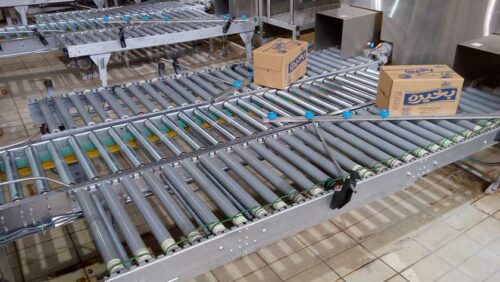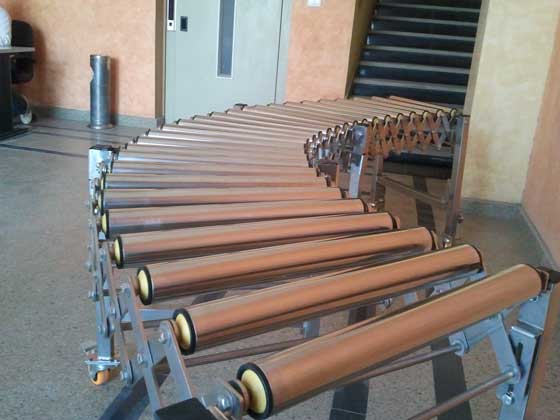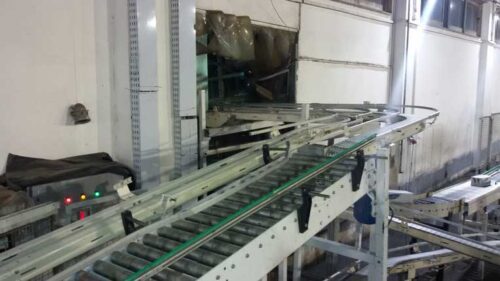Roller Conveyors:The Smooth Operators Of Material Handling
Roller conveyors are a type of material handling equipment that uses a series of rollers to move loads from one point to another.
You might thenk conveyors are widely used in various industries to transport items such as boxes, crates, bags, and other types of containers or products.
Roller conveyors provide a smooth and efficient way to move materials, making them an essential component in many manufacturing, warehousing, and distribution operations. Read More
-

- Roller Conveyors for production line
-

- Roller Conveyors for production line
How Do Roller Conveyors Work?
Roller conveyors work on a simple principle: as the rollers rotate, they create a low-friction surface that allows objects to easily move along the conveyor line.
The rollers on roller conveyors are usually placed close together, and various methods like gravity, chains, or belts can power their rotation.
Some roller conveyors are portable, while others are permanently installed as part of a larger material handling system.
Roller Conveyor
Roller Conveyor
Gravity Roller Conveyor
Roller Conveyor
ENTRA Offers wide range of conveyorSystem Suitable for all roduction lines
Check out our conveyor systems below

Curved Roller Conveyors
- Gravity roller conveyors are the simplest type of roller conveyor.
- They rely on the force of gravity to move objects along the conveyor line

Stinless Steel Wheel Roller Conveyor
- These conveyors are typically slightly inclined, allowing the items to roll down gently
Types of Roller Conveyors
Gravity Conveyors Gravity roller conveyors are the simplest type of roller conveyor.
They rely on the force of gravity to move objects along the conveyor line.
These conveyors are typically slightly inclined, allowing the items to roll down gently.
Gravity roller conveyors are often used for short-distance transportation or in areas where power sources are not readily available.
- Powered Conveyors Powered roller conveyors use an external power source to rotate the rollers, allowing for more control over the speed and direction of the conveyor line.
- There are two main types of powered roller conveyors:
- Chain-Driven Conveyors In chain-driven conveyors, each roller is connected to a continuous chain that runs along the length of the conveyor.
- The chain is powered by a motor, which causes the rollers to rotate and move the items along the conveyor line.
- Belt-Driven Conveyors Belt-driven roller conveyors use a flat belt that runs beneath the rollers.
- The belt is powered by a motor, causing the rollers to rotate as the belt moves.
- This type of conveyor is often used for heavier loads or in applications where a smooth, continuous flow is required.
Benefits of Using Roller Conveyors
Increased Efficiency Roller conveyors can significantly increase the efficiency of material handling operations.
They allow for quick and smooth transportation of items, reducing the need for manual labor and minimizing the risk of delays or bottlenecks in the process.
Improved Safety By automating the movement of materials, roller conveyors help reduce the risk of injuries associated with manual handling, such as back strain or crush-related accidents.
They also eliminate the need for workers to lift or carry heavy loads, improving overall workplace safety.
Space Optimization can be designed to make efficient use of available space, either by utilizing overhead space or by creating compact, streamlined layouts. This space optimization can be particularly beneficial in facilities with limited floor space.
ENTRA also provide Belt Conveyors to serve as alternatives for some types of production lines
Applications of Roller Conveyors
Warehouses and Distribution Centers
Roller conveyors are essential components in warehouses and distribution centers, where they are used to move goods from receiving areas to storage locations,
They help streamline the flow of materials, improving productivity and reducing the risk of damage to products
Manufacturing and Assembly Lines
In manufacturing and assembly lines, roller conveyors are used to transport components, subassemblies, and finished products between different workstations or areas.
They help maintain a consistent pace and ensure a smooth flow of materials throughout the production process.
Packaging and Sorting Operations
Roller conveyors are commonly used in packaging and sorting operations, where they help move items from one stage of the process to the next.
They can be integrated with other equipment, such as labeling machines or sorting systems, to create a seamless and efficient workflow.
Request a Quote?
Are you ready to request a standard model? We have many Conveyor types to offer. Fast shipping is available on some ‘quick ship’ models.
Frequently asked questions
-
Can roller conveyors handle heavy loads?
Yes, roller conveyors are available in different load capacities, ranging from light-duty conveyors for small packages to heavy-duty conveyors capable of handling loads weighing several tons.
-
How long can a roller conveyor system be?
Roller conveyors can be designed to cover a wide range of lengths, from just a few feet to hundreds of feet long.
-
Are roller conveyors suitable for outdoor use?
While most roller conveyors are designed for indoor use, there are specialized versions that can be used outdoors. These conveyors are typically constructed with weather-resistant materials and may include additional features, such as covers or enclosures, to protect them from the elements.
-
Can roller conveyors be used to transport fragile items?
Yes, roller conveyors can be used to transport fragile items, such as delicate electronics or glassware, by incorporating features like low-friction rollers, gentle curves, and padded surfaces. Additionally, the speed and acceleration of the conveyor can be adjusted to minimize the risk of damage.
-
How often do roller conveyors need to be maintained?
The frequency of maintenance depends on factors such as the conveyor type, usage levels, and operating conditions. As a general guideline, most manufacturers recommend regular inspections (e.g., monthly or quarterly) and preventive maintenance tasks, such as lubrication and cleaning, to ensure optimal performance and longevity.

